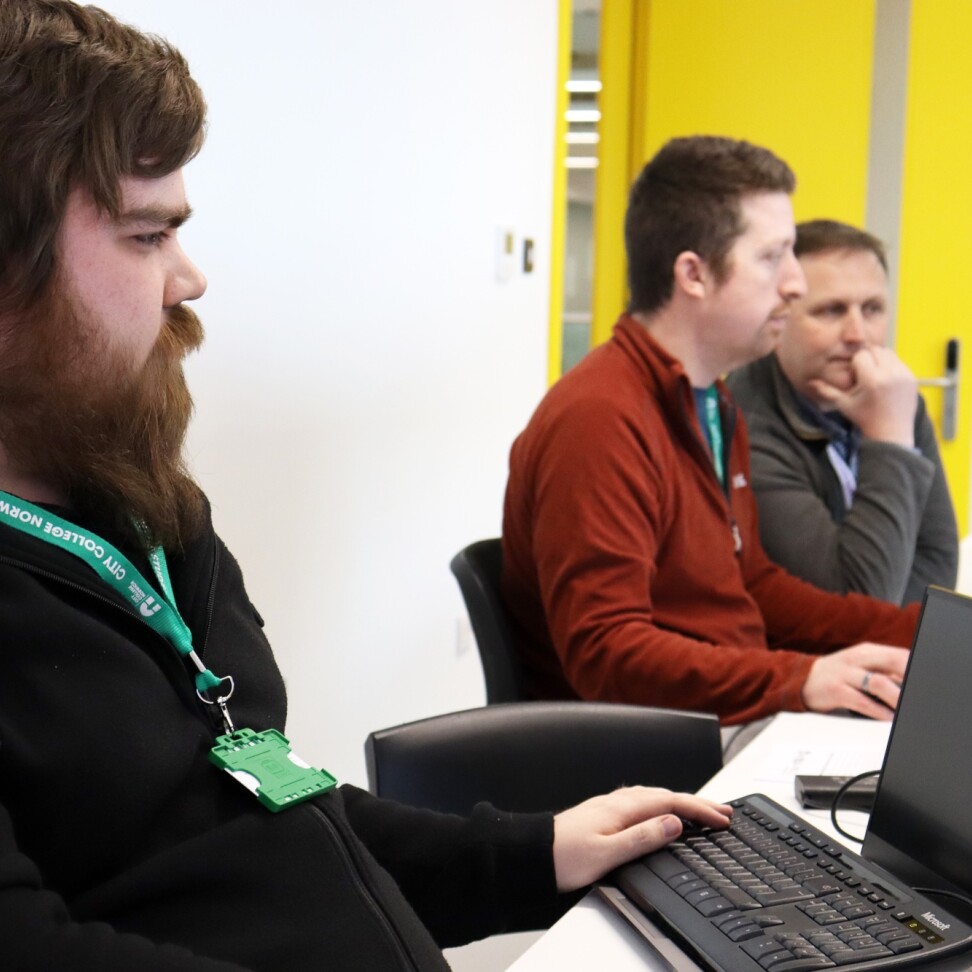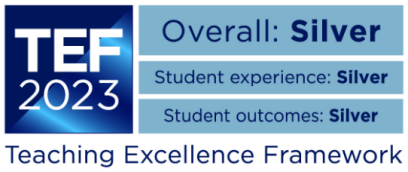HND Digital Technologies - Cyber Security (HTQ)

Have you always been eager to explore the nature of cyber crime, and investigate cyber security threats and hazards? Then HND Digital Technologies - Cyber Security (HTQ) could be the perfect option for you! Throughout this course, you will develop and apply your own ideas to your studies, deal with uncertainty and complexity, explore solutions, demonstrate critical evaluation, and use both theory and practice in a wide range of digital technology situations.
- Level
- 5
- Entry Point
- Sep 2025
- Duration
- Full Time, 2 years
- Venue
- City College Norwich campus
- CCN Course Code
- F0095
Reasons to study
this course
The purpose of Pearson BTEC Higher Nationals is to develop students as independent-thinking professionals who can meet the demands of employers and adapt to a constantly changing world. The qualification aims to widen access to higher education and improve the career prospects of those who take them.
This course lays the foundation of learning by providing a broad introduction to digital technologies and to a range of digital technology specialist functions, developing and strengthening your core skills. The units prepare you to move on to specific areas of digital technologies or to enter employment with the qualities and abilities necessary for roles that require personal responsibility and decision making.
You will gain a wide range of knowledge tied to practical skills gained through research, independent study, directed study and workplace scenarios. You are involved in vocational activities that help you to develop vocational behaviours (the attitudes and approaches required for competence) and transferable skills. Transferable skills are those such as communication, teamwork, research and analysis, which are highly valued in higher education and the workplace.
Simon Rhodes - HE Development Manager
My name is Simon, and I am the HE Development Manager. Prior to joining City College Norwich, I worked for 20 years in the aviation industry, including management roles within procurement, and technical training. I currently work with colleagues as part of the School of HE Leadership team to help develop our provision, and increasingly to manage our interactions with the Office for Students (OfS), who are the main regulator for Higher Education in England. I manage both the HE Office, and our HE Student Recruitment / Student Support teams, who work directly to support students. Please contact me if you have any questions about this course.
Where will this
course take you?
This programme is widely recognised by employers and professional bodies, and can provide pathways to both further education and membership of relevant professional bodies.
Course structure
This course is studied full time over two years. The programme is delivered over two days a week - 30 teaching weeks per year
Level 4 modules
Professional Practice in the Digital Economy Core
This unit provides a foundation for good practice in a variety of contexts, and provides an opportunity for you to examine the evolution and impact of digital technologies on work environments. You will explore the importance of professional development for career success and the benefits of working towards goals for career success. In addition, problem solving extends the need to demonstrate transferable and communication skills. Finally, working with others is an integral part of everyday life, and the ability to give and receive feedback is a necessary skill to support professional development planning. Therefore, understanding role responsibilities and how to work with peers and colleagues will ensure that there is a better understanding and awareness to support your own professional development.
Innovation and Digital Transformation Core
Many businesses manage to remain competitive by using their ability to adapt strategies and re-think their old operating models in response to fundamental changes in the market. Technology gives these organisations the opportunity to evolve and to increase their value to their customers; modern services are increasingly moving online – making digital transformation a necessity. In 2019, the global spending on digital transformation technologies and services grew around 18%. This unit aims to give you a comprehensive understanding of digital transformation.
Digital transformation constitutes the integration of digital technology into all areas of a business to maximise the Return on Investment (ROI), meaning that there will be fundamental changes to business operations and culture. In this unit, we will look at a number of tools and techniques that organisations use to transform and become more innovative in their approach. These include frameworks and related elements such as operational agility, culture, leadership, customer experience, and integration of digital technology.
Cyber Security Core
Digital technologies provide an opportunity for malicious hackers and cyberterrorists to exploit individuals, government, institutions and large organisations. Defending against cyber-attacks, including insider threats, is a priority within the digital technologies sector. Cybercrime techniques and attack vectors are fast growing, taking advantage of the speed, anonymity and convenience of the internet as a facilitator for malicious and criminal activity.
This unit has been designed to develop your knowledge and understanding in relation to cyber threats and vulnerabilities, cyber defence techniques and incident response. You will explore fundamental principles as well as leading-edge concepts, terminologies, models and hardening methods. You will assess the types of malicious activity and potential targets, and the role everyone has in maintaining cyber resilience.
On successful completion of the unit, we will have explored the nature of cybercrime and cyber threat actors, looked into the roles and responsibilities in relation to information assurance, assessed the threats to, and vulnerabilities in, ICT infrastructure and investigated strategic responses to cyber security threats.
Programming Core
Programming involves describing processes and procedures that are derived from algorithms. The ability to program is what sets apart a developer from an end user. Typically, the role of the developer is to instruct a device (such as a computer) to carry out instructions; the instructions are known as source code and are written in a language that is converted into something the device can understand. The device executes the instructions it is given. Algorithms help to describe the solution to a problem or task by identifying the data and the process needed to represent the problem or task and the set of steps needed to produce the desired result. Programming languages typically provide the representation of both the data and the process; they provide control constructs and data types (which can be numbers, words and objects, and be constant or variable). The control constructs are used to represent the steps of an algorithm in a convenient yet unambiguous fashion. Algorithms require constructs that can perform sequential processing, selection for decision making, and iteration for repetitive control. Any programming language that provides these basic features can be used for algorithm representation.
This unit introduces you to the core concepts of programming, along with an introduction to algorithms and the characteristics of programming paradigms. Among the topics included in this unit are: introduction to algorithms, procedural, object-orientated and event-driven programming, security considerations, the integrated development environment and the debugging process.
On successful completion of this unit, you will be able to design and implement algorithms in a chosen language in a suitable Integrated Development Environment (IDE). This IDE will be used to develop and help track any issues with the code. As a result, you will develop skills such as communication literacy, critical thinking, analysis, reasoning and interpretation, which are crucial for gaining employment and developing academic competence.
Big Data and Visualisation Core
Exploring and analysing big data translates information into insight. The purposeful, systematic exploitation of big data, coupled with analytics, reveals opportunities for improved decision making and better business outcomes. All this data is useful when processed but requires visualisation to bring to life. Data visualisation makes big data easier for the human brain to understand and detect patterns, trends and meaning in complicated data sets. With such rapid advancement in this area, there have been considerable challenges for data specialists to develop the skills, experience and growth required to maintain innovation in the sector. Similarly, the public and private sectors have struggled to keep up with progress, meaning that the introduction of legislation and community norms have been retrospective and, at times, reactive.
As data continues to be the fuel for the digital economy, this area remains a constant topic of conversation for organisations and governments, and the public who share an interest in its growing commercial use, manipulation and presentation. This unit introduces you to the concepts of big data and visualisation, and how this is used for decision making. You will explore the industry software solutions available for investigating and presenting data, before assessing the role and responsibility of data specialists in the current environment. You will examine topics including data-driven decision making, manipulating data and automation, and building ethics into a data-driven culture. You will demonstrate your use of tools and software to manipulate and prepare a visual presentation for a given data set. You will also assess how data specialists are responsible for adhering to legislation and ensuring data compliance.
On successful completion of this unit, you will be able to investigate the value of data for decision making to both end-users and organisations; compare how different industry leading tools and software solutions are used to analyse and visualise data; carry out queries to summarise and group a given data set, and analyse the challenges faced when building ethics into a data-driven culture. You will have the opportunity to progress to a range of roles in the digital sector and will develop industry-led skills, analysis, and interpretation, which are crucial for developing practical experiences with big data and for gaining employment.
Networking in the Cloud Core
Complex computer networking has connected the world via groups of smaller, linked networks to support global communications. These can be situated within ‘the cloud’, at home, with your employer, or elsewhere. As a cloud computing professional, a question that must always be asked is ‘What remote and local networking infrastructure is supporting our cloud communication?’. The evolution of cloud computing is driven by all forms of network infrastructure allowing users to access data, hardware and services regardless of location. Being knowledgeable about the underlying principles of networking is of vital importance to all cloud professionals, whether they work in cloud support roles, cyber security. or cloud software development.
The aim of this unit is to give you a wider background knowledge of cloud networking principles, operational principles, protocols, standards, security considerations and the systems associated with a range of networking technologies. This unit gives you the underpinning knowledge of the principles of networks and supports a range of other units in the qualification. You will explore a range of cloud solutions and will configure them to gain knowledge of networking systems. A range of networking technologies will be explored so that you gain a fundamental knowledge of Local Area Networking (LAN), Wide Area Networking (WAN) and their evolution, to form scalable systems.
On successful completion of this unit, you will have gained knowledge and skills to be able to successfully implement, operate, and improve a cloud network and the operation of cloud-based data networks; this includes router, switching technologies, IP routing technologies, IP services and basic troubleshooting.
Security Core
Security is one of the most important challenges modern organisations face. It is about protecting organisational assets, including personnel, data, equipment and networks, from attack through the use of prevention techniques in the form of vulnerability testing/security policies and detection techniques; this exposes breaches in security and implements effective responses.
The aim of this unit is to give you knowledge of security, the associated risks, and how it has an impact on business continuity. You will examine security measures involving access authorisation and regulation of use. You will also implement contingency plans and devise security policies and procedures. The unit also introduces you to detection of threats and vulnerabilities in physical and IT security, and how to manage risks relating to organisational security.
This unit includes network security design and operational topics, including address translation, DMZ, VPN, firewalls, AV, and intrusion detection systems. Remote access will be covered, as will the need for frequent vulnerability testing as part of organisational and security audit compliance.
Networking Core
Computer networks are the driving force behind the evolution of computer systems and allow users to access data, hardware, and services regardless of their location. Being knowledgeable about the underlying principles of networking is of vital importance to all IT professionals. Networking is an environment that is increasingly complex and under continuous development.
Complex computer networking has connected the world by groups of small networks through internet links to support global communications. It supports access to digital information any time, anywhere, using many applications like email, audio and video transmission, including the World Wide Web; this has opened the floodgates to availability of information.
The aim of this unit is to give you a wider background knowledge of computer networking essentials, how they operate, protocols, standards, security considerations and the prototypes associated with a range of networking technologies. We will explore a range of hardware, with related software, and will configure and install these to gain knowledge of networking systems. A range of networking technologies will be explored to deliver a fundamental knowledge of Local Area Networking (LAN), Wide Area Networking (WAN) and their evolution to form large-scale networks. We will also explore the protocol methodologies related to IP data networks.
On successful completion of this unit, you will have gained the knowledge and skills needed to successfully install, operate and troubleshoot a small network; and the operation of IP data networks, router, switching technologies, IP routing technologies, IP services and basic troubleshooting. Supporting a range of units in the Higher National suite, this unit underpins the principles of networks for all and enables you to work towards your studies in vendor units, if applicable.
Level 5 modules
Business Intelligence Core
Modern business intelligence focuses on having a comprehensive view of an organisation’s data and to then use that data to drive change, eliminate inefficiencies, and quickly adapt to market or supply changes. The necessity of having meaningful information is the key driver for effective decision-making and problem-solving. Business intelligence can help companies make better decisions by showing present and historical data within their business context. Business intelligence has evolved from technologies such as decision support systems (DSS) to include tools and methods associated with data mining, data integration, data quality and data warehousing, in conjunction with other information management systems and applications.
This unit introduces you to a range of tools, techniques and technologies for acquiring data and processing this into meaningful information that can be used to support business functions and processes. Within this unit we will examine the concept of business processing in terms of data capture, conversion and information output. You will also be required to define the tools and technologies associated with business intelligence functionality. You will develop a business intelligence tool and demonstrate techniques to understand a given problem. Finally, you will be expected to evaluate the impact of business intelligence for effective decision-making.
On successful completion of this unit you will be able to appreciate the importance of business intelligence in terms of optimising decision-making and performance. By exploring the tools, techniques and systems that support business intelligence, you will have an awareness of the role and contribution that these technologies and methodologies have and their importance to organisations.
Internet of Things Core
This unit introduces you to the role, basic concepts and benefits of The Internet of Things (IoT) in the design and development process of computer applications. The aim of the unit is to enhance understanding of the methodology, terminology and benefits of IoT in the design and development of software applications.
IoT is a network of physical objects – devices, vehicles, drones and other objects embedded with electronics, software, sensors and network connectivity – that enables those objects to collect and exchange data. The objective of the IoT is to enable almost any object to become smart, accessible, and data capable, thereby benefitting from advances in communications, computation and interconnectivity. IoT explores the mixture of hardware, software, data, platforms, and services that can be combined to create innovative opportunities for more direct integration of the physical world and objects into computer-based systems; resulting in improved efficiency, accuracy, and social and economic benefits.
Among the topics included in this unit are: classification and terminology of IoT; the hardware, software, data, platforms and services used to enable IoT; common architecture, frameworks, tools, hardware and APIs that can be utilised to design IoT-enabled objects; problems and solutions resulting from widespread deployment and adoption of IoT; software application methodology for IoT-specific software application design and development; data models; network complexity; security; privacy; enabling technologies; and how to simulate and test an IoT concept.
On successful completion of this unit, you will be able to: explain the basic concepts of IoT; design, build and simulate an IoT application using any combination of hardware, software, data, platforms and services; discuss the problems that IoT applications solve; the potential impact on society, business and the end user; and the problems encountered when integrating into the wider IoT ecosystem.
Emerging Technologies Core
This unit introduces you to the role, benefits, disadvantages and potential outcomes that emerging technologies have in the development of software applications and business practices. The aim of the unit is to enhance your understanding of the current types, terminology, advantages, disadvantages, potential impact and benefits of emerging technologies.
Emerging technologies have the ability to disrupt industries, radically change the progress and thinking of humankind, affect society at large and solve huge problems. Computing underpins many emerging technologies; it allows rapid development and the sharing of ideas, products and scientific understanding across multiple fields in shorter and shorter timeframes. The objective and effect of emerging technologies is usually to change the status quo. This change might be to solve problems, increase performance, improve efficiency, or to create entirely new scientific fields and novel technologies by converging different systems, technology, thinking and disciplines. Emerging technologies include changing technologies that display radical novelty, have the potential for significant commercial or social impact and fast growth and scalability, and which affect the future in uncertain ways.
Among the topics included in this unit are: classification and terminology of emerging technologies; review of the most promising and impactful emerging technologies; trends of convergence; the impact of emerging technologies on software development; and an understanding of the scale and scope that emerging technologies may have on organisations and their employees, and the individuals served by them. On successful completion of this unit, you will be able to explain some of the most promising and impactful emerging technologies and their advantages and disadvantages. You will understand the impact that emerging technologies have on the development of software applications.
Applied Security in the Cloud Core
This unit gives you the opportunity to implement security in a cloud-based infrastructure. We will explore common threats and how to defend a cloud system. You will design security policies, ensuring that your cloud-based system has effective security management.
The challenge of securing systems is ever present regardless of where the system is situated, whether in premises or the cloud, the opportunities and threats are the same. This issue affects customers, corporate partnerships, governments and educational institutions. Streaming services, ecommerce solutions and mobile applications rely heavily on cloud provisioning, so a secure solution is essential.
Whilst traditional ‘on site’ security risks still exist and must be managed, the approach to security in a professional setting must be different. Professional working in this field must adapt to the remote situation, understand how secure cloud services operate, and understand the potential behaviours of cybersecurity threat actors. Any security configuration must be responsive and must not impede the functionality and performance of the cloud environment. In the culture of cloud defence there is a need to continually assess and review threats – exploring vulnerabilities and mitigating them whenever feasible.
Many computing and cloud infrastructure professionals require a broad understanding of applied cloud security principles as part of their core skills portfolio. In the context of cyber security, cloud security assures an essential element of end-to-end security in a corporate infrastructure.
Applied Cryptography in the Cloud Core
Almost every interaction we make with an electronic device will involve cryptography in some form. Cryptography is an indispensable tool for protecting information in computer systems. Applied cryptography for cloud services uses encryption techniques that protect data used, shared, and stored in the cloud. Cryptography underpins many aspects of security and is a crucial component in protecting the confidentiality and integrity of information. The dangers of uploading data into this new environment require cryptographers and cryptanalysts to protect the cloud environment using a variety of technologies, processes and forms of encryption. The complexity with how cloud computing manages data secrecy and information security is a reason why people avoid the cloud. As a result, despite the hype surrounding cloud computing, some users remain reluctant to deploy their personal information or to deploy commercial enterprises into the cloud. Understanding cloud security issues, the application of crypto algorithms and ensuring that data is secured are vital to its continued functionality, longevity and sustainability.
This unit introduces students to the applied principles of cryptography and looks at its practical applications and methods, many of which are fundamental to secure data in the cloud. You are expected to analyse fundamental symmetric, asymmetric and hashing encryption methods, and investigate examples of these in practice. Further, you will learn to demonstrate the use of cryptography and cryptanalysis tools, methods and their applications. You are also expected to appraise the inner workings of cryptographic protocols and principles, including transport layer security (TLS) and blockchain, and evaluate how they can be used by organisations to enhance security when considering a move to a cloud environment. Among the topics included in this unit are: the mathematical algorithms used in cryptography, the mechanisms by which cryptographic and cryptanalysis work, hashing and salting, cloud-hosted Public Key Infrastructure (PKI), benefits of encryption techniques, quantumcryptography, secure multi-party computation, security risks and issues with public key encryption, practical applications of cryptography and Cryptography as a Service (CaaS).
On successful completion of this unit, you will be able to understand the differences in the roles and responsibilities of a cryptographer and a cryptanalyst. You will be able to analyse functions of stream ciphers and block ciphers, produce code implementing ciphers, analyse methods such as KEM, DEM and PKEs to secure data in a cloud environment. You will also design a security case and implement it.
Information Security Management in the Cloud Core
As organisations move to cloud platforms, an understanding of security is more important than ever. It is often inferred that Cloud Service Providers (CSPs) are solely responsible for security risks. In reality, security risks in the cloud are a shared responsibility with the organisation and its users. The question organisations need to be asking is not ‘How secure is the cloud?’ but rather ‘Are we using the cloud securely?’. Through an understanding of security best practices and requirements, organisations can implement security controls and threat protection in a cloud environment that supports established governance and compliance frameworks. Jobs in cloud security entail the development and execution of the organisation’s security initiatives, designing and documenting security solutions in line with standards, work with CSPs to secure best practices, carry out audit activities and identify risk-based needs for decision making.
This unit introduces you to the principles of information security governance and explores key principles of ISO standards for meeting assurance, quality and performance standards. You will investigate the use of an Information Security Management System (ISMS) and how cloud service providers support solutions for protecting data in organisations. You will also analyse the challenges of using cloud-based ISMS solutions and design a Security Posture Assessment to use in a cloud environment. Among the topics included in this unit are security threats and risks, ISO 27000 series, risk treatment planning, ISMS and concept of CIA, cloud-based ISMS solutions, Security Posture Assessment, risk assessment methodologies, and governance frameworks. On successful completion of this unit, you will be able to explore security standards and certifications, and the process of establishing and maintaining an ISMS. You will prepare a business case for a cloud-based ISMS solution and recommend a suitable risk management framework to ensure security governance and compliance in the cloud.
Work-based Learning in the Digital Economy Subject to change
This unit is one of two that were chosen by the course team from a range of options.
As a professional, learning is a continuous and lifelong process. In the digital industries, there is constant change in technology, materials, processes, legislation, and practice. In order for organisations to remain up to date, they need to recognise the potential of both structured, formal based learning and learning gained through professional activities in the studio, office, workshop or on site.
Whether through a traditional industry placement, a freelance opportunity, or a simulated industry situation, it is important for you to be able to recognise key industry structures and their related employment patterns and characteristics. Effective workplace learning requires both the application of a skillset and the implementation of appropriate attitudes and behaviours.
This unit provides a framework in which you will have the opportunity to reflect on and contextualise the learning gained from working in the industry. In coordination with tutors and an employer, you will define the scope, duration, and content of your expected work-based learning experience. Throughout the period of your work-based learning experience, you will be expected to record your experience and reflect on your learning.
Digital Sustainability Subject to change
This unit is one of two that were chosen by the course team from a range of options.
Living and working in the 21st century in the digital technologies sector presents a range of unforeseen sustainability challenges. These challenges are based on, among other potential issues, mineral resource, ethical working and employment practices, economic impact, supply chain, and climate impact.
Digital technologies is a sector in the frontline of the battle to overcome the challenges of creating a sustainable economy, but no single discipline has the capability to tackle the problems. Sustainability is a multidisciplinary challenge and technologists of the future will have to work collaboratively with a whole range of other stakeholders in order to find, within an urgent timescale, the practical and technological solutions needed.
On successful completion of this unit, you will have gained a wide range of knowledge and understanding of the issues and topics associated with sustainability and low impact digital technology solutions. You will have explored the interdisciplinary context of sustainability and how the development of a low carbon economy is essential in the digital technology sector. You will also have explored a current digital technology solution and evaluated its impact and potential sustainability, evaluating a range of solutions and data sources.
Course details
Assessment methods
A wide range of assessment techniques will be covered in this course, ranging from scenario based course work and projects, practical work and demonstrations, time constrained assessments, and both group and individual presentations. Units will be graded at an overall pass, merit or distinction (or fail if the learning outcomes have not been achieved).
Awarded by
This course is awarded by Pearson and regulated by The Office for Students.


Entry requirements
You will need:
Grades at A* to C (or equivalent) and/or 9 to 4 (or equivalent) in Maths and English, AND one of the following:
- BTEC Level 3 qualification in Computer Science or other related Level 3 qualification
- GCE Advanced Level profile that demonstrates strong performance in a relevant subject or adequate performance in more than one GCE subject.
- An Access to Higher Education Diploma from an approved further education institution
- An international equivalent to the above qualification
Mature Students
Mature students with relevant industrial background may also be considered subject to interview.
Course fees
HNC or HND "Top Up" £6,720, International Fee: £8,120
Full HND (240 Credits) £13,440, International Fee: £16,240
Pearson Registration Fee:
In addition to the course fees, there is also a Pearson registration fee, which they have not yet set for 2024/25, which will be charged separately to the tuition fees above.
As a guide, the 2023/24 BTEC Level 4 and 5 Higher National Student Registration (HTQ HND) fees were £374.05, in year one, with a further £23.00 learner registration in each subsequent year of study.
We were awarded a TEF Silver rating overall in 2023, achieving this for both student experience and student outcomes.

Search courses
Search CCN HE



